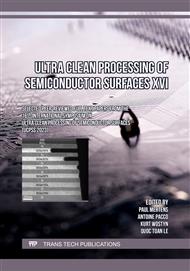p.231
p.236
p.244
p.253
p.258
p.263
p.268
p.275
p.280
Optimal Injection Distance in Ultrasonic Water Flow Cleaning
Abstract:
Cleaning tests with ultrasound-superposed water jets are performed to explore the optimal injection distance from the jet nozzle to a glass plate spin-coated with small silica particles (as a cleaning sample). The cleaning performance is evaluated based on particle removal efficiency (PRE) that is calculated using the haze method. Visualization of the water jet and liquid film flow over the cleaning target shows that the jet flow with short injection distance tends to be in a steady state, while the water jet shape instability grows for long injection distance, leading to atomization of the jet. The cleaning tests with varying the injection distance suggest that there exists an optimal injection distance at which the PRE becomes maximal.
Info:
Periodical:
Pages:
258-262
Citation:
Online since:
August 2023
Permissions:
Share:
Citation:


